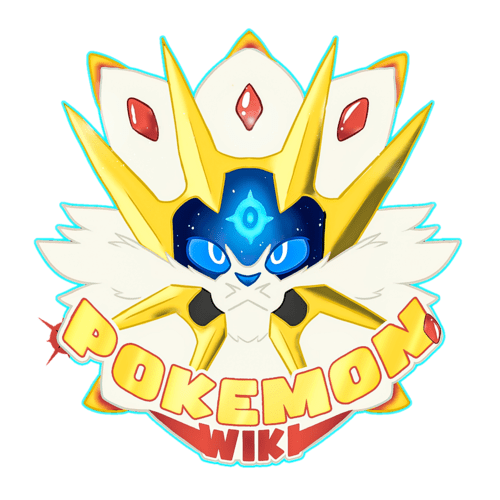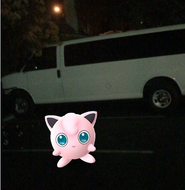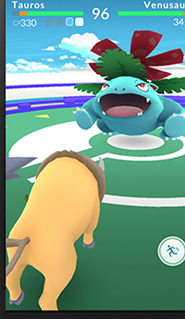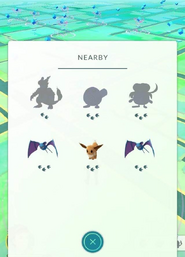No edit summary Tag: rte-source |
No edit summary Tag: rte-source |
||
| Line 7: | Line 7: | ||
|player# = 1 |
|player# = 1 |
||
|ESRB = E10+ |
|ESRB = E10+ |
||
| − | |release-date-japan = |
+ | |release-date-japan = 2016 |
|release-date-canada = July 17, 2016 |
|release-date-canada = July 17, 2016 |
||
|release-date-north-america = July 7, 2016 |
|release-date-north-america = July 7, 2016 |
||
Revision as of 15:52, 19 July 2016
Template:Gameinfobox Pokémon GO is an Android and iOS-free downloadable game.
The game is based around catching, trading and battling Pokémon in real life through augmented reality, using the devices having Android and iOS systems installed.
Pokémon GO Plus can be separately purchased along with Pokémon GO. The device will enable the wearer to effectively search for Pokémon through the use of Bluetooth for the Apple or Android mobile phone.
Game mechanics
Catching
So far, only the Generation I Pokémon (the original 151) are confirmed to be catchable. The Pokémon's location varies based on the actual landscape (e.g. water-type Pokémon are likely to be found at rivers or oceans, while rock-type Pokémon are likely to be found at caves).
The trainer has to find a Pokémon, which is shown on the local map. If there are no footprints aside a Pokémon's sprite, the Pokémon is very close to the trainer and appears directly on the map, while more footprints indicate the Pokémon is further away, but they all can be put on the list to be tracked later on. To attract Pokémon to the trainer, an incense can be used, or a Lure Module can be used to attract Pokémon to a PokéStop. Once the Pokémon is found, by tapping the phone, the trainer initiates a battle. The trainer has to throw a Poké Ball at an exact angle to capture the Pokémon. A white circle represents the area in which the Poké Ball must be thrown in order to catch the Pokémon. A colored circle appears inside this white circle. The smaller the circle, the more likely the trainer is to catch the Pokémon.
Additional experience is earned for throwing the ball inside the colored circle. If the colored circle is roughly the size of the white circle or slightly smaller, the trainer will be rewarded with 10 experience for a "nice" throw. If the colored circle is roughly half the size of the white circle, one will be rewarded with 50 experience for a "great" throw. If the colored circle is tiny, one will be rewarded with 100 experience for an "excellent" throw. Similarly, the trainer can spin the Poké Ball to throw a curveball and earn a bonus of 10 experience. Please note that the bonus experience for a "nice", "great", or "excellent" throw does not stack and will overwrite the bonus for a curveball.
These bonus experience points are affected by experience multipliers. To make the capture easier, the trainer can use either a Great or an Ultra Ball to catch the Pokémon, or a Razz Berry to distract the Pokémon. A camera can also be used to take photos of the field. Once the Pokémon is caught, the trainer receives an amount of Stardust and the captured Pokémon's respective candy.
A colored circle indicates how difficult to catch a Pokémon is:
- Green - easy, the Pokémon will most likely be caught
- Orange - normal, the Pokémon could escape out of the Ball
- Red - difficult, the Pokémon is likely to come out of the Ball
Evolving and hatching
To evolve a Pokémon, the trainer must give the caught Pokémon some candies, which are obtained through the game by catching other Pokémon, hatching Pokémon eggs, or transferring Pokémon to the professor. The candy is only compatible with its respective Pokémon and its evolved forms, e.g. for Squirtle candies can only evolve Squirtle and Wartortle and no other Pokémon besides them. Pokémon with three-stage evolution need 25 candies to evolve for the second stage. Pokémon with two-stage evolution and second evolved form for three-stage evolution require 50 candies.(This only applies to the current Generation I Pokémon; Pokémon like Cleffa do not exist in that generation.) These are exceptions:
- Weedle, Caterpie and Pidgey require 12 candies to evolve into their respective second evolutions.
- Eevee and Rattata require 25 candies to evolve.
- Poliwhirl, Haunter, Wartortle, Ivysaur, Charmeleon, Nidorino, Nidorina, Graveler, Kadabra, Machoke, Gloom, Dragonair and Weepinbell require 100 candies to evolve.
- Magikarp requires 400 candies to evolve into Gyarados.
The trainer can also hatch eggs, allowing them to obtain rare-to-find Pokémon. The trainer has to visit a PokéStop to obtain the egg. To hatch the egg, the trainer must place it in an Egg Incubator (which can be found or bought in the online shop), then walk a distance. Riding a vehicle will not count as progress. Eggs can be found that require either 2km, 5km, or 10km to hatch. Eggs that require a longer distance traveled to hatch give rarer Pokémon. Hatching eggs also gives large random amounts of stardust and candies of the hatched Pokémon.
| Distance to hatch | Hatching Pokémon |
|---|---|
| 2km (1.24 miles) | Charmander, Bulbasaur, Squirtle, Caterpie, Weedle, Pidgey, Rattata, Spearow, Pikachu, Clefairy, Jigglypuff, Zubat, Geodude, Magikarp |
| 5km (3.10 miles) | Ekans, Sandshrew, Nidoran♀, Nidoran♂, Vulpix, Oddish, Paras, Venonat, Diglett, Meowth, Psyduck, Mankey, Growlithe, Poliwag, Abra, Machop, Tentacool, Bellsprout, Ponyta, Slowpoke, Magnemite, Farfetch'd, Doduo, Seel, Grimer, Shellder, Gastly, Drowzee, Krabby, Voltorb, Exeggcute, Cubone, Lickitung, Koffing, Rhyhorn, Tangela, Kangaskhan, Horsea, Goldeen, Staryu, Tauros, Porygon |
| 10km (6.21 miles) | Onix, Hitmonlee, Hitmonchan, Chansey, Mr. Mime, Scyther, Jynx, Electabuzz, Magmar, Pinsir, Lapras, Eevee, Omanyte, Kabuto, Aerodactyl, Snorlax, Dratini |
Miscellaneous
The trainer can receive experience to level up and gain new items and unlock other ones.
At level 5, trainers can join teams -Team Instinct, Team Mystic and Team Valor - allowing them to battle against other teams in Gym battles. Teams have a name; a leader (Spark, the leader of Team Instinct, Blanche, the leader of Team Mystic and Candela, the leader of Team Valor); a Legendary Mascot (Zapdos, Articuno and Moltres respectively) and a corresponding color.
| style="Template:RoundyL" | Team Instinct | Team Mystic | style="Template:RoundyR" | Team Valor |

|

|

|
At level 5, trainers can conquer Gyms from battles against opposing Teams.
PokéStops are places for trainers to acquire items for free, such as Pokéballs and Eggs; Potions, Revives and Razzberries at level 5; Super Potions at level 10; Great Balls at level 12 and Hyper Potions at level 15.
Combat Points or CP, is an indicator of a Pokémon's power, be it a wild or a trainer's Pokémon.
The Pokémon use moves differently than in the other games.
Items
In Pokémon GO, some items can be received through leveling up. However, the trainer can also buy them by using PokéCoins, which is the currency in-game.
| Amount of PokéCoins | Price in ¥ (Japan) | Price in € (EU), $ (US) | Price in £ (UK) | Price in $ (AUD) |
|---|---|---|---|---|
| 100 | 120 | 0.99 | 0.79 | 1.49 |
| 550 | 600 | 4.99 | 3.99 | 7.99 |
| 1200 | 1200 | 9.99 | 7.99 | 14.99 |
| 2500 | 2400 | 19.99 | 14.99 | 30.99 |
| 5200 | 4800 | 39.99 | 29.99 | 62.99 |
| 14500 | 11800 | 99.99 | 79.99 | 159.99 |
Achievements
In Pokémon GO, several achievements, called Medals, can be obtained, through the game, mostly by capturing a certain amount of Pokémon.
Videos
Gallery
Template:Spinoff
















